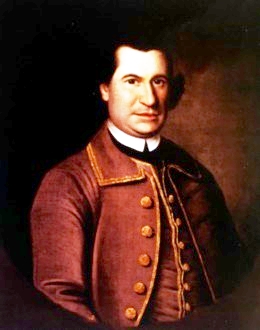Daniel Campbell
Ulsterman Daniel Campbell is known primarily as a merchant and trader of Schenectady. However, during the 1760s and 70s, he owned property in Albany and was involved somewhat in city-related activities. The Campbell surname is prominent in the Albany and the regional historical record. We seek clarity in delineating kinship connections within the general clan.
This Daniel Campbell is said to have been born in Ulster, Ireland in September 1730. He emigrated to America in 1754 and soon found his way to Schenectady. Perhaps, he came to serve in (or was connected to) a British army regiment - as he later received a military land bounty. Arriving with limited means, Daniel Campbell "set off for the Indian Country with a pack on his back." Soon, he became acquainted and then allied with countryman William Johnson, the premier British-identified settler in the region. Prospering in the fur trade, and benefiting from his business connections to the royal government and service, he made his home in the developing village on the south side of the Mohawk.
In 1760, he married Engeltie Bradt, daughter of the Schenectady branch of a prominent New-Netherland era family. The marriage seemed to have produced only son Daniel who was christened 1766. The parents were pillars of St. George's Anglican church in Schenectady. During the 1760s, artist and one-time Schenectady resident Thomas McIlworth painted companion portraits of Daniel and his wife.
Successful in business, he was able to acquire real property in Schenectady (where he built a grand home), as a partner in regional patents, and also in the city of Albany. He was a prominent Anglican churchman and a justice of the peace.
Beginning in 1757, his name appeared on the rolls of the Schenectady militia, the New York provincial troops as captain, and then as major of the the militia regiment under the authority of Sir William Johnson. He appears to have served Sir William in a number of places and capacities into the 1770s. He was also referred to as "Coll. Campbell" - although that commission has not been located.
In 1766, his house in Albany was valued moderately on the city assessment roll. At the same time, his Schenectady property ranked among the highest of assessments.
In January 1774, "Daniel Campbell of Schenectady" was named among the many executors of the estate of Sir William Johnson.
Prominently British-identified, he would have been high on any list of those who might try to remain loyal to the king. Owning substantial Albany property, the tax on his personal property was relatively steep. However, while in Albany during the war, he probably lodged with Hugh Denniston or another Anglo innkeeper.
Under constant scrutiny by Albany's wartime political organizations, Campbell initially sought to stand against the revolutionaries but later acquiesced and thus was able to survive the war. His travails during the conflict have been well documented. ![]()
By 1790, he was identified as the head of a Schenectady household. A decade later, his family was enumerated in the landmark State Street location.
Daniel Campbell filed a will in July 1801. He died in August 1802 shy of his seventy-second birthday. His widow was the principal beneficiary of his estate followed by a nephew living in London. Engeltie Bradt Campbell lived a decade longer. Both partners were buried in the Schenectady church plot.
The principal purpose of this sketch is to place this locally renowned subject in his Albany context - albeit (like William Johnson and other non native notables) a small part of his life.
Online resources: Digital Schenectady;
McIlworth portraits: McIlworth executed what may be companion portraits of Daniel and Engeltie (Angelica) Bradt Campbell perhaps while he was living Schenectady during the mid 1760s. Both are said to be in the collections of the Winterthur Museum. However, only Angelica/Engeltie's likeness appears to be accessible online. The image appearing here is a poorly executed phonographic snapshot (that means with my "iPhone") from Ona Curran's Thomas McIlworth, pp. 21, 35 that will serve until a more suitable digital likeness is available.
The index to the published Johnson Papers (vol. 14, beginning on page 78) describes the connection in more detail - including a chronology of the association.
